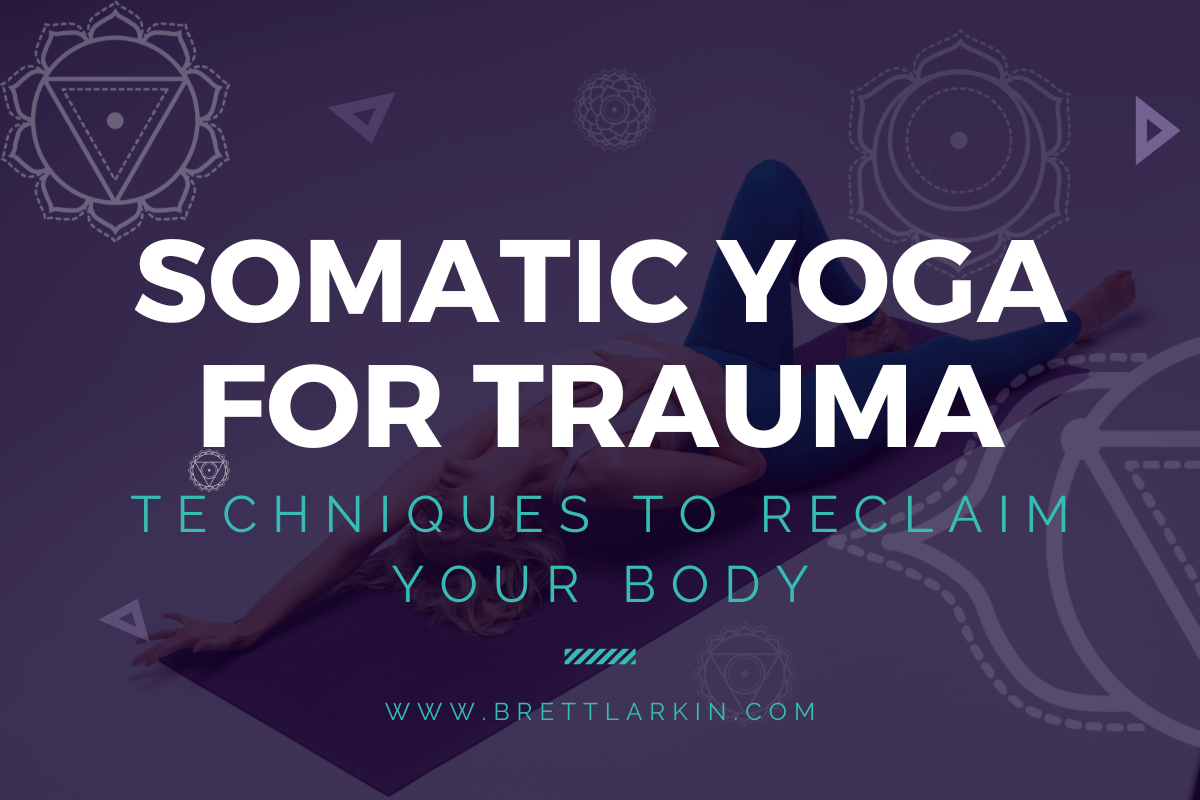If you had asked me how my childhood was five years ago, I would have said, “Great!” Sure…
…My parents divorced when I was 8, my father was ill my whole life, but I wasn’t sexually abused. I didn’t survive a school shooting. I’d never been physically attacked.
THOSE things are traumatic.
Compared to those things, my childhood was boring.
But here’s what my Somatic Coach helped me realize: We all have complex trauma.
Peter Levine, a renowned psychologist and expert in the field of trauma healing, defines trauma as “an injury caused by an overwhelming event that is beyond a person’s capacity to cope.”
Let’s face it, life can throw us some curveballs, causing a particular trauma response and leaving us with wounds that aren’t always visible on the surface.
But here’s the thing: healing is possible, and so is trauma recovery. Somatic yoga, a trauma sensitive yoga and an arm of somatic therapy, uses somatic exercises to release tension and process a traumatic event in a safe, nurturing way.
It addresses the “issues in your tissues” through bypassing the intellectual mind, working with the animal body and soothing the nervous system.
Whether you’re dealing with past experiences or navigating present challenges, this gentle yet powerful practice is healing trauma in a more effective way.
Keep reading to find out how.
What Is Somatic Yoga For Trauma?

Somatic yoga for trauma is a specialized approach to yoga integrating somatic principles and yogic practices to support trauma healing in people who’ve had past traumatic experiences – a.k.a. everyone.
It’s a union of somatic experiencing to the yoga asana practice you already know and love.
In somatic therapy, emphasis is placed on creating a safe and nurturing environment for nervous system regulation. One where you can practice self care, heal trauma, explore physical sensations, emotions and increase body awareness.
This type of therapy for trauma recognizes the interconnectedness of the body and mind, acknowledging that trauma is stored in the psyche AND in the physical body.
Through gentle movement, breathwork, embodiment, and mindfulness practices, somatic yoga offers you a way to release stored trauma energy, regulate your nervous system, and cultivate greater resilience and self-awareness.
I believe this trauma sensitive yoga is a powerful tool for healing and transformation.
My approach combines the wisdom of yoga with trauma-informed techniques to create a supportive and empowering environment for you to reclaim your body and your power.
I train my somatic coaches in methods like:
✅ Regulation – creating safety and stability in the body
✅ Titration – working with small parts of a traumatic experience at a time
✅ Oscillation – going back and forth over a point of equilibrium
✅ Unwinding – releasing a pattern of constriction by focusing within the tension
✅ Presence – the ability to see what’s happening in and outside of your body
Whether you’re navigating the aftermath of a single traumatic event or grappling with complex trauma, somatic experiencing on the mat can help you cultivate a sense of agency in your healing journey.
Take my feminine energy quiz to get a recommended practice for balancing YOUR feminine energy 👇
Why Somatic Yoga?

From childhood trauma to the collective trauma of our anxiety-riddled world, YOU are likely operating from a survival response – stuck in old behavior patterns.
The best way to uncover the root cause of these wounds and heal them is through the kind of intuitive, self-guided movement that a somatic yoga practice can help you access.
Think of trauma in two ways:
1️⃣ Big “T” trauma is caused from major traumatic events usually leading to symptoms of PTSD: combat, natural disasters, physical abuse.
2️⃣ Little “t” trauma is less severe, chronic, more commonplace stressors that lead to C-PTSD: bullying, neglect, constant criticism, divorce, loss.
This trauma lives in your body and when you repress it, you create habitual bracing patterns manifesting as tension, discomfort, or dissociation, potentially for years or decades.
Beyond moving and breathing, Somatic Yoga is designed to help your body discharge stress, express emotion, and release repressed rage.
Science has proven the best way to “close the loop” on your stress cycles (beyond simply exercising and breathing) is to:
✨ emote (a.k.a “make some noise)
✨ cry
✨ yawn
✨ punch
✨ kick and stomp
ALL things we do in Somatic Yoga.
Somatic yoga recognizes the interplay between the body and the mind, offering a safe space for you to explore and release trauma held within your body.
Unlike traditional talk therapy, which primarily engages the cognitive mind, somatic yoga integrates movement, breathwork, and mindfulness practices to bypass the mind and get you into your body. How? You:
💎 Reconnect with the sensations of your body.
💎 Access and process traumatic experiences on a somatic level (using the language of the body — breath and movement).
💎 Reclaim a sense of safety and agency.
Moreover, somatic yoga uses gentle mindful movements to foster a nurturing and supportive environment where you can explore past trauma experiences with compassion and without judgment.
Working with a yoga therapist or somatic coach is a great way to start using somatic experiencing to increase your mind body connection and release repressed emotions. Or you can explore these ideas at home with me in this class.
Benefits Of Somatic Yoga For Trauma Release
If you haven’t found anything that helps your depression or trauma, I encourage you to try somatic yoga. Somatic yoga often works when other modalities have failed because it’s designed to address the root cause of an individual’s trauma through a process of unwinding.
Somatic release addresses the fact that you need to unwind these bracing patterns through movement and expression in a way that is UNIQUE to you. There’s no one-size-fits all approach.

Somatic yoga works as a precursor to intuitive movement in which you bring awareness to tension and work to unwind tension along the same neural pathway to find balance in the nervous system. Addressing trauma through YOUR body’s wisdom, is a holistic approach to healing honors the interconnectedness of mind, body, and spirit.
Through the language of the body (breath and mindfulness), and movement to release stored energy, you can experience health on a whole new level.
Here are just some of the many benefits of somatic yoga:
- Regulation of the Nervous System: When the autonomic nervous system is going haywire, we need the parasympathetic nervous system to balance things out. Somatic therapy regulates the nervous system helping the body process trauma, stress, and pain. This promotes a sense of calm and safety and reduces symptoms of hyperarousal.
- Release of Stored Trauma Energy: Through gentle movement and breathwork, somatic yoga releases stored trauma energy held in the body, promoting emotional release and healing.
- Cultivation of Resilience: By cultivating greater self-awareness and empowerment, somatic yoga helps individuals build resilience and cope more effectively with stress and adversity.
- Improvement in PTSD Symptoms: Research has shown that somatic yoga can reduce symptoms of post-traumatic stress disorder (PTSD), such as intrusive thoughts and hypervigilance while also improving overall well-being and quality of life. That’s why you often see a mental health clinician including it in PTSD treatment.
- Nurturing Environment for Exploration: Somatic yoga provides a safe and nurturing environment to explore your body, sensations, and emotions, fostering a sense of trust and connection with yourself and others. You no longer have to feel unsafe. Instead, you’ve found a way to support and embrace your feelings in the moment.
Experience My Somatic Yoga Workshop (usually $67) FREE!👇

Best Somatic Yoga Poses To Release Trauma
The body tends to take the path of least resistance in order to conserve energy. That means you tend to think the same thoughts, do the same things and move in the same ways, even in your yoga practice. Somatic therapy is about doing things differently in order to open up new neural pathways in the brain. The goal is to move in non-habitual, atypical ways.
Here are four yoga poses you can make more somatic to reduce stress, release trapped emotions, and increase your mind body connection.
Child’s Pose with Somatic Exploration

Instructions:
- Sit on your heels. You can place a cushion between your legs.
- Close your eyes and take a few deep breaths. ADD TOUCH. Explore touching your face, arms, legs: Inhale, rub down from hip to knee. Exhale, rub up from knee to hip. As you explore what feels good, start playing with different types of touch, like a lighter touch (with just one or two fingers) versus a deeper massage.
- Exhale, fully rest your forehead forward to the floor, leading with your chin. Let yourself rest here.
- Inhale, come back up to sitting. Repeat as needed.
Legs-Up-The-Wall Pose (Viparita Karani)

Instructions:
- Lie down on your back, in savasana, facing a wall.
- Raise your feet up and scooch your torso and sits-bones closer to the wall.
- Try a few different variations: a bolster under your hips, spreading your legs into a V on the wall, the soles of the feet on the wall to windshield wiper the legs or maybe add pelvic rocks.
- ADD SHAKING. If you choose, before coming out of traditional Viparita Karani, shake the legs vigorously. (Learn more about the power of somatic shaking in this blog post).
- When you feel complete, pull your knees down into your chest and rock back and forth. Like an Upside Down Child’s Pose.
- Take your time and roll to your side, lying with one hand on your head, the other hand on your belly. Take a few deep breaths here.
Somatic Supine Twist

Instructions:
- Lie on your back in savasana.
- Shift your hips to the left, then drop your knees to the opposite side.
- Find what feels best: crossing/uncrossing your legs, angel arms, a butterfly hug. ADD TOUCH. Massage the outer hip or place a palm on the heart.
- Just like above, move into lying on your side when you’re done.
Somatic Cat-Cow Stretch

Instructions:
- Start in Table Pose (hands and knees). Wrists under shoulders; hips over knees.
- Cow: Inhale, shine your heart forward, roll your shoulders back and then arch your back (keep the back of your neck long). Tuck your toes under. Let the head and neck explore moving.
- Cat: Exhale, push your hands into the floor and draw your belly button up and in. Make a rainbow shape with your back toward the ceiling. Pull the chin in to gaze at your belly. If you want to sit back, that’s okay.
- From here, alternate between Cow and Cat. ADD SPIRALS. Instead of linear cat/cow, begin rolling or circling the hips. Circle the seat, hips and booty. Make circles with your whole torso, shifting the weight over each wrist and knee. Go at your own pace and your own breathing rhythm. Move in a way that is pleasurable and calls to you.
If you’d like to try a guided practice, try one of these classes:
Final Thoughts
Somatic experiencing is all about nurturing your mind body connection and deepening your body awareness, so you can feel your physical sensations and heal any stuck trauma response in your interconnective tissue.
As a yoga teacher, I recommend somatic yoga for trauma to anyone who is currently in therapy for trauma or is dealing with trapped emotions and looking for ways to reduce stress.
Somatic therapy is one of the best things you can do for your mental health. Offering a gentle yet powerful pathway to healing, honoring the interconnectedness of mind, body, and spirit.
Learn to do this for yourself in my go-at-your-own-pace Home Study Somatic Yoga Certification or help others as a Somatic Yoga Life Coach.

FREE Embodied Yoga Workshop (usually $67) Somatic Techniques & Cord Cutting Ritual

Next Steps
- Take a deep dive into embodiment and somatic yoga with my Somatic Yoga certification program.
- If you’re interested in practical kriya yoga as a way to improve your daily life and relationships, check out my Yoga for Self Mastery course.
YOU MIGHT ALSO LIKE
- 7 Top Somatic Yoga Books to Regulate Your Nervous System
- 5 Best Somatic Yoga Apps for Nervous System Regulation
- Top Somatic Coaching Programs And How To Choose One
- Somatic Yoga Workshop Ideas for Teachers
- Somatic Yoga for Cortisol Detox: A Gentle Path to Stress Relief and Nervous System Healing
- Gentle Somatic Yoga: Heal Chronic Pain, Release Trauma, and Reclaim Your Bod
- Somatic Meditation: A Body-Based Approach to Healing Stress, Anxiety, and Trauma
- Advanced Pelvic Floor Breathing: A Somatic Approach to Healing
- Somatic Yoga For Yoga Teachers: Everything You Need to Know in 10 Steps
- How Somatic Shaking Can Release Tension and Reset Your Nervous System
- Discover Somatic Pilates: Enhance Your Body Awareness and Flexibility
- Kundalini for Feminine Energy: Ignite Your Creative Power and Passion
- 6 Effective Somatic Yoga for Neck and Shoulders
- How to Teach Somatic Yoga: A Practical Guide for Instructors
- The Best Somatic Exercises for Grief: Find Healing Through Movement










